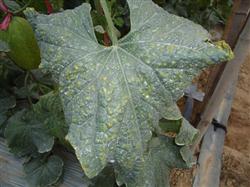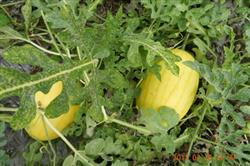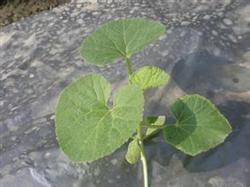Chemical Control of bacterial Leaf spot in Hami Melon

Symptoms: melon can occur during the whole growth period. It is mainly harmful to leaves, but also to fruits and vines. Leaf infection: round to irregular light yellowish brown, translucent spot can be seen on the leaf. True leaves are infected, water stains appear on the leaves, the disease spots gradually expand, limited by the veins of the leaves, showing polygonal to irregular shape, sometimes the back of the leaves are overflowing with yellow-white bacterial pus, and the diseased leaves are dry and yellowish brown in the later stage, and the disease spots are easy to crack and fall off. Stem and fruit infection: primary waterlogging, sunken spots, with a large amount of bacterial mucus, fruit surface disease spots are easy to fester, cracks, extended inward to the seeds, resulting in seed carrying bacteria. Pathogen: Pseudomonas clove tears pathogenic variety, belonging to bacteria. Control methods: (1) select disease-resistant varieties. (2) the remaining seeds from disease-free melons can be sterilized with 70 ℃ constant temperature and dry heat for 72 hours, or soaked in 50 ℃ warm water for 20 minutes, removed and dried, soaked for 30-60 minutes, or soaked in 40% formalin for 1.5 hours or 1 million units of streptomycin sulfate for 2 hours. (3) raising seedlings in disease-free soil, rotation with non-melon crops for more than 2 years, strengthening field management, removing diseased leaves during growing period and after harvest, and burying deeply in time. (4) to promote rain shelter cultivation and carry out preventive chemical control in the open field, spraying 14% ammonia copper solution at the beginning of the disease or at the beginning of spread, or 50% nail cream copper wettable powder, 50% copper succinate (DT) wettable powder, 60% ethylphosphine aluminum (DTM) wettable powder, 77% wettable particulate powder, 60-75 liters per mu. Company defense for 3-4 times. Copper succinate has a certain preventive effect on powdery mildew and downy mildew. In addition, 4000 times solution of streptomycin sulfate or 72% agricultural streptomycin soluble powder, or copper soap solution of 1 rime or 300-400 Bordeaux solution can be selected. 400000 units of penicillin potassium salt is also effective when water is diluted to 5000 times.
- Prev

Techniques of grasping whole and strong seedlings in Hami melon planting
The soil of Hami melon must be disinfected before each crop cultivation in order to kill the bacteria, eggs, insect bodies and harmful substances secreted by the plants themselves. The common methods of soil disinfection are gas disinfection, chemical disinfection, high temperature disinfection, irrigation disinfection and so on. After practice, cantaloupe cultivation land.
- Next

Methods and techniques of soilless cultivation of Hami melon
In recent years, the area of anti-season cultivation of Hami melon in Hainan has gradually expanded by using economic greenhouse. Compared with open field cultivation, Hami melon is a kind of cash crop with high input and high output. The seed price of Hami melon is expensive and the disease in seedling stage is more serious. the causes of seedling death of Hami melon are described and the control methods are put forward. ...
Related
- Moge, come on! The staff of the peasant association in the producing area of cantaloupe were frightened when the crowd gathered.
- Causes and Solutions of low Fruit setting rate of Apple
- Symptoms and control measures of passion fruit virus disease
- Fruit growing lesson: how do apple orchards keep high yields?
- Can you build orchards in the mountains? What are the pros and cons?
- How to manage the coloring period of Crisson grape?
- This paper introduces the processing technology of two kinds of fig products.
- How much is a month for retired teachers in rural areas by 2020?
- How can strawberry planting increase sugar content? We should pay attention to management in many aspects.
- What are the cultivation techniques on how to improve the yield of golden fruit?

